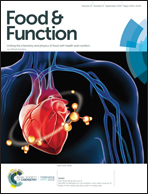Impact of different roasting conditions on chemical composition, sensory quality and physicochemical properties of waxy-barley products†
Abstract
The consumption of β-glucan-rich barley can contribute to a healthy diet. Sensory properties may be improved by roasting whereby the nutritional value should be preserved. The aim of the present study was to investigate the impact of different roasting conditions (160–200 °C, 20 minutes) on sensory quality, health-related compounds and viscosity in β-glucan-rich barley kernels, thin and thick flakes. Sensory quality was improved by roasting. Acrylamide levels increased due to roasting to maximum values of 322 μg kg−1 (kernels), 586 μg kg−1 (thin flakes) and 804 μg kg−1 (thick flakes). No relevant impact of roasting on the contents of fat, protein, starch and β-glucan was observed, whereas dietary fibre fractions were marginally modulated. Roasting significantly decreased viscosity 1.9-fold (kernels), 2.4-fold (thin flakes) and 2.7-fold (thick flakes), on average. In conclusion, improved sensory quality along with a favourable healthy composition of barley products may be achieved by roasting over a low to medium temperature range.



 Please wait while we load your content...
Please wait while we load your content...